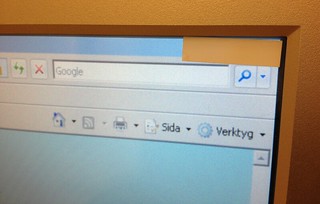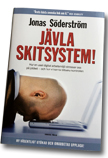The doctor that rocks the mouse
Publicerad 24 september 2012 | 3 kommentarer
Henrik Ahlén was bewildered. Each of the three computers he was looking at was connected to a humming test tube rocker (the machine that rocks your blood test sample, so it won’t coagulate).
But something wasn’t right. These computers were not placed in a laboratory. The scene was a waiting room at the Department of Rheumatology in a Swedish hospital. So why the test tube rockers – and why were the computer mice placed on the trays of the small machines?
At this hospital in Stockholm, Sweden, patients with arthritis have to fill in a questionnaire before their appointment with their physician. The patients answer a number of questions about joint pain and stiffness.
Earlier, the questionnaire was a bundle of paper. Now it’s digital – on those very computers in the waiting room. (That questionnaire was the software Henrik Ahlén, veteran digital consultant, was working with now.) The big advantage of digital is that the data is entered directly into the patient’s Electronic Health Record, which saves a lot of time. When the patient meets her doctor, he already has a summary of the results on his screen, and they can discuss the best treatment.
But why on earth had someone put the humming and shaking test tube rockers there, and why place the computer mice on them?
It turned out, that all the computers in the hospital network where controlled by a central security system. After only a few minutes of inactivity, the system automatically shuts down all software running on the computer and logs out. This configuration was impossible to change, and the IT policy did not allow for any exceptions.
But patients show up at the rheumatology department irregularly, and not in every five minutes. So time and again, the computers in the waiting room were locked. Each and every time, a nurse or a doctor had to dash out in the waiting room and log in – a process that took considerable time. And all the time that was supposed to be saved disappeared!
Finally someone got the idea to place the computer mouse on the tray of the test tube rocker. This moves the cursor continually on the screen, and the computer won’t be logged out.
When Henrik interviewed the staff about the security system, they literary saw red. There were countless other difficulties and inconveniences with this and other systems in the workplace – and just a few of them could be solved with nifty workarounds.
There was actually one more of them at this computer station: Henrik noted that a post-it note covered the upper right corner of the screen. Why?
Well, when patients are ready, they’re supposed to press a ”Save” button on the screen. But a lot of them instead press the Windows’ ”Close” icon in the upper right corner (perhaps they were determined not to let the next person see their entries). But this also shut down the machine, and the data they had entered were lost! Solution: cover the icon with a piece of paper or tape!
Just let me give you two conclusions here.
First, to really find out what’s important to the users, and how a system is actually used, you need to spend time observing real users, in the field.
Second, it’s in the workplace we most often encounter these strange situations. It’s hard to imagine a consumer product so badly adapted to the needs of the users. At work, however, we encounter awkward and time-consuming (rather than time-saving) systems all the time. Why do we accept that?
What’s this: I’m a Swedish UX designer and writer, specializing in systems used in the workplace. This blog is about my most recent book, covering how such badly designed systems are a major cause of stress (and eventually even health problems). You can read a bit more about it in English here. I tweet as @jonas_blind_hen (in English and in Swedish, mixed).
Oh, and if you’re around, I’ll give a talk at Euro IA Summit in Rome next weekend (September 28-29, 2012) about ”Stupid bloody system! – Bad IA in the workplace, the causes of stress, and the rise of bureaucracy 2.0”.
(If you liked this, you’ll probably also enjoy the post ”What’s the waiter doing with the computer screen?”.)
(Thanks to Henrik Ahlén at AlfaBravo for sharing, and Pontus Rydin for editing help!)
Kommentarer
3 kommentarer to “The doctor that rocks the mouse”
Skriv en kommentar



25 september 2012 @ 15:34
Hi nice examples of badly designed software. It also shows how many ideas going out to customers can give you.
As a nice anecdote, I have tried to apply for a patent a couple of years ago for a small USB stick that mimics a moving mouse, to prevent computers from locking up :-). It wasn’t deemed new enough but your story does show the value of such a solution. Better yet Microsoft should improve their software.
12 oktober 2012 @ 12:52
I don’t know if it’s patented, but you can buy it readymade:
http://www.wiebetech.com/products/MouseJiggler.php
they should run chrome/IE in kiosk mode, instead of taping the close button!
your point still stands: Real testing, with real people should’ve reavealed this.
10 maj 2018 @ 23:55
[…] The post linked at the end is also interesting: http://javlaskitsystem.se/2012/09/the-doctor-that-rocks-the-… […]